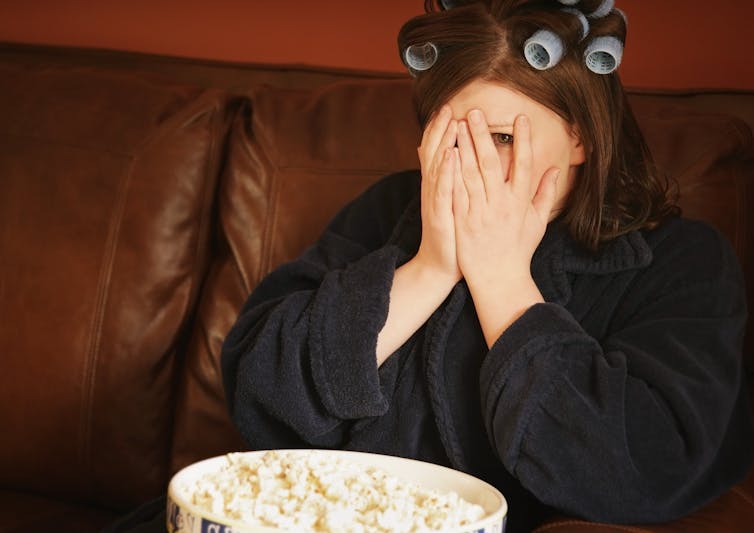Why we like to watch crap
Carly Drake, North Central College and Anuja Anil Pradhan, University of Southern Denmark
 |
| When someone humiliates themselves on TV, you want to look away, but you can’t. Designpics/Getty Images |
Cringe is the feeling you get when your boss cracks a joke in a meeting and no one laughs.
It’s when your kid shoots a soccer ball and it misses the net by … a lot. It’s when you watch Kendall Roy from “Succession” awkwardly rap on stage at a celebration honoring his dad’s 50 years at the helm of the family company.
This secondhand embarrassment you feel for other people, real or fictional, is physical and emotional. It’s the gut punch of a gasped “oh no!” paired with a side of “I’m glad that wasn’t me” relief.
Research usually sees cringe in a negative light – as a voyeuristic emotion that allows people to gawk at the misfortune of others.
However, in a recent study, we show that cringe-filled entertainment can actually help people better understand themselves and one another. This may be a big reason why people are so drawn to cringeworthy content in the first place.
Studying cringe
Cringe is everywhere, but it’s especially ubiquitous in movies and on TV, where it elicits winces, laughs and embarrassment in viewers.
Scripted cringe comedy shows such as “The Office” and “Curb Your Enthusiasm” have been widely successful. These shows often feature characters encountering uncomfortable social situations and handling them with little or no grace – like when Toby, in “The Office,” awkwardly touches the knee of his crush, Pam.
Cringe is also a notable hallmark of reality TV, where cast members or contestants expose themselves to public heartbreak, fail spectacularly at physical challenges or endure humiliating critiques from judges.
In our study, we examined the first season of Netflix’s “Indian Matchmaking,” a show that follows matchmaker Sima Taparia as she guides her clients in India and the U.S. through the arranged marriage process.
Now in its third season, the show has received an Emmy nomination and inspired a spinoff called “Jewish Matchmaking.”
In our research, we used our own experiences as data through a process called collaborative autoethnography. Specifically, we wrote and analyzed our reactions to each episode in the first season of “Indian Matchmaking.”
Our diary entries were full of moments of secondhand embarrassment – whether it was witnessing a first date filled with uncomfortable silences, or watching a participant show us his closet with doorknobs that have his face on them.
By analyzing these entries, we generated in-depth insights into what it means to cringe.
Everyone bumbles through life
What was surprising was that the cringeworthy scenes weren’t always accompanied by a sense of voyeurism or feelings of schadenfreude.
Instead, we found that binge-watching a show with a lot of cringeworthy moments can be, dare we say, therapeutic.
Cringe made us recognize the parts of ourselves that we saw as undesirable.
Watching “Indian Matchmaking,” we were reminded that, like the people on the show, we haven’t always performed well in the dating market. One participant who brought this form of cringe to life for us was Aparna. A successful lawyer living in Houston, she could come off as abrupt or rude – “Oh, do we have to see our husbands all the time?”
Throughout the show, Taparia tries to make Aparna “compromise” – in other words, settle for men she doesn’t see as worthy of her. Taparia, as well as fans of the show, have called Aparna an unrealistic perfectionist.
Aparna’s interactions with Taparia are fraught, and various tensions play out – modern values versus traditional ones, and what makes a woman desirable versus undesirable. There’s a sheen of sexism to this dynamic: Aparna is chastised for behavior that men on the show are excused for.
Having navigated similarly perfectionist tendencies in our dating lives, we saw ourselves represented in Aparna’s journey. We even would often refer to each other as “Aparna” while emailing about this study.
Our affinity for Aparna reminded us of watching Michael Scott from “The Office.”
We’ve seen him make a grand gesture to declare his love for someone too early in a relationship – and not get an “I love you” back – or argue with his partner in front of friends at a dinner party and thought, “I’ve been there” or “I’ve seen that.”
While previous research shows that audiences distance themselves from television personalities like Aparna or Michael Scott, we couldn’t help but embrace cringeworthy representations of the less-than-desirable aspects of our personalities.
It was, in a strange way, freeing to see other people bumble through life, and made us think about being less hard on ourselves.
A way to confront our biases
When we watched “Indian Matchmaking” and cringed, we sometimes wondered why, exactly, we were cringing in the first place.
In “Indian Matchmaking,” first dates often include discussions about personal finances and the number of kids each person wants to have.
 |
| On ‘Indian Matchmaking,’ first dates often include topics of conversation that Westerners would avoid. Netflix |
If you grew up in a Western country, you might feel your stomach clench while watching these conversations.
But in other parts of the world, this is actually perfectly normal and expected. In India, marriage is often about more than just romantic love; it is a union between two families, and this entails hashing out logistics early on. There is no playing it cool.
So in this way, cringe can alert viewers to their values and judgments and lead to reflections about cultural differences.
Cringing at exploitation and mockery
Then there’s the sort of cringe that arose when, midseason, we started to question why a show like “Indian Matchmaking” was made in the first place.
It’s like when you see videos of white people volunteering in low-income countries with their white savior complex on full display.
Our reaction diary entries are riddled with questions about the way the showrunners edited – or even manipulated – the characters’ stories.
Some diary entries talk about cringing when a scene appears clearly staged, or when the showrunners appear to be mocking the characters, like when the show plays silly music when showing first dates.
What sort of responsibility do the showrunners have toward the audience, Indian and otherwise? While the show highlights social issues such as sexism, does it ever really challenge or confront them?
The show has also been criticized for propagating casteism and portraying India as a backward country.
We cringed when we realized we were complicit in these undercurrents of discrimination because we watched, laughed and professionally benefited from this show.
However, we ultimately felt that our allegiance is not with the showrunners, or with those in the arranged marriage process who perpetuate the patriarchy. It was with the people in the show who remind us of ourselves.
Cringe is more than a fleeting feeling or fodder for yet another reality TV franchise, and maybe it’s a good thing that so many people are drawn to this sort of content. In our case, pushing past secondhand embarrassment and reflecting a bit helped us better understand ourselves and each other.![]()
Carly Drake, Assistant Professor of Marketing, North Central College and Anuja Anil Pradhan, Assistant Professor of Consumption, Culture and Commerce, University of Southern Denmark
This article is republished from The Conversation under a Creative Commons license. Read the original article.